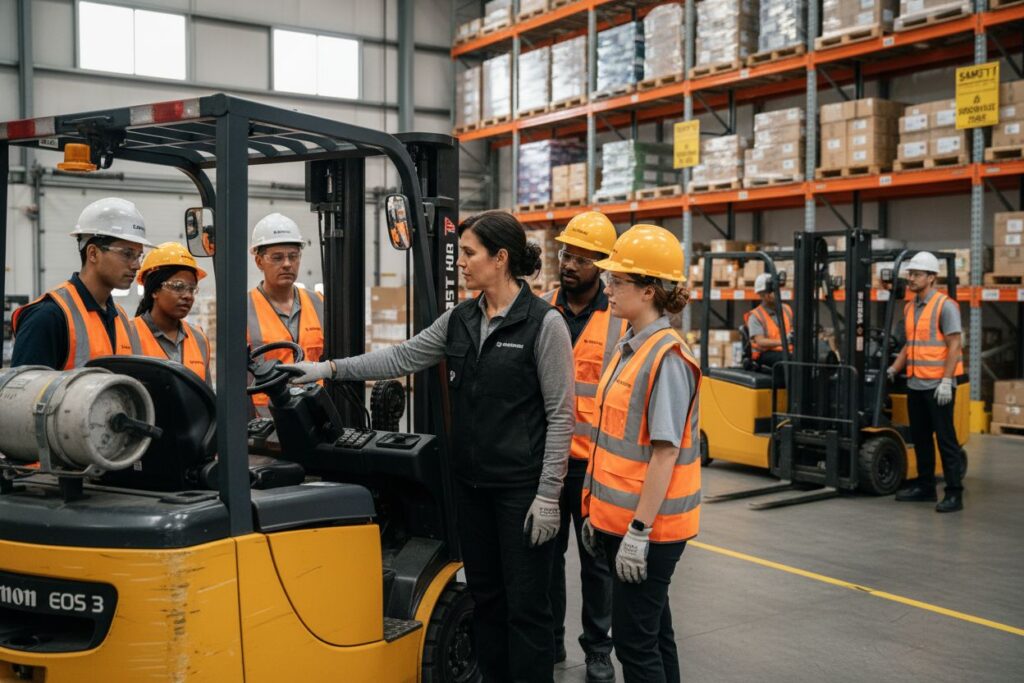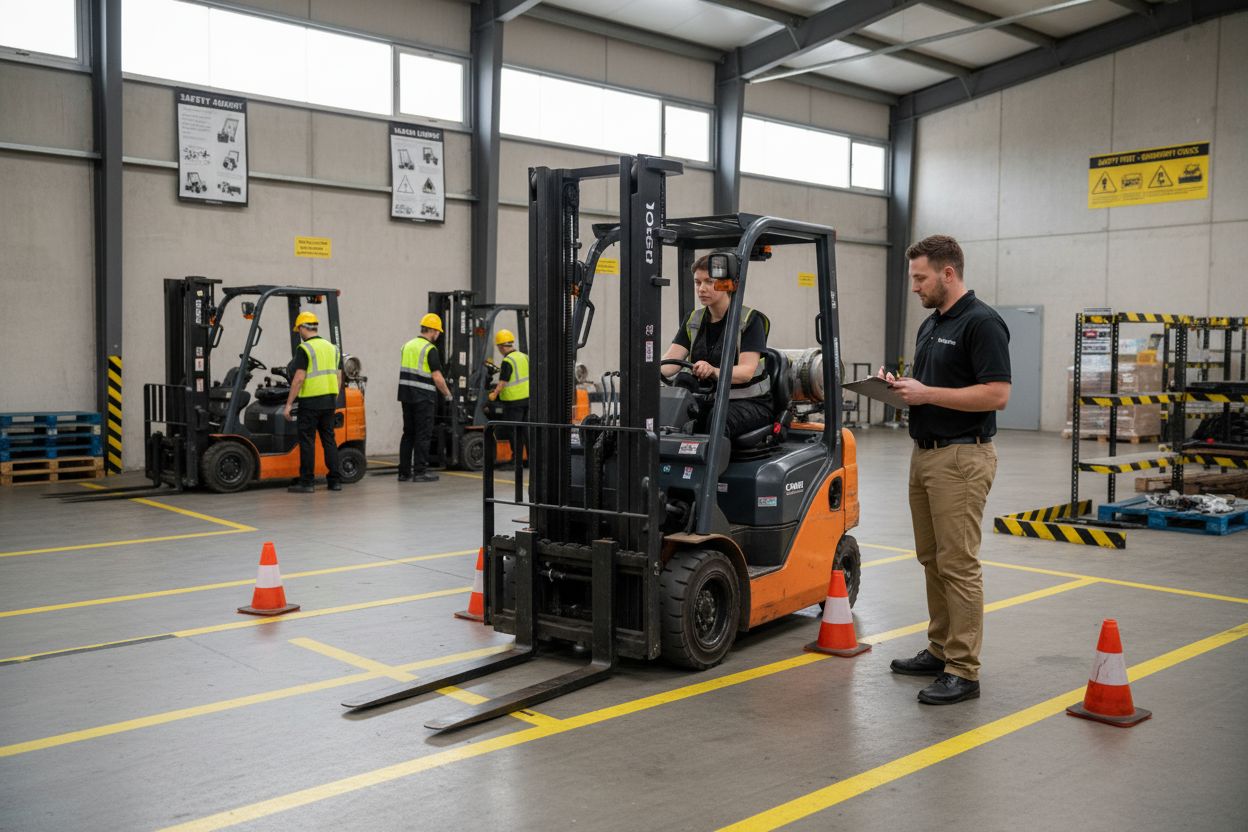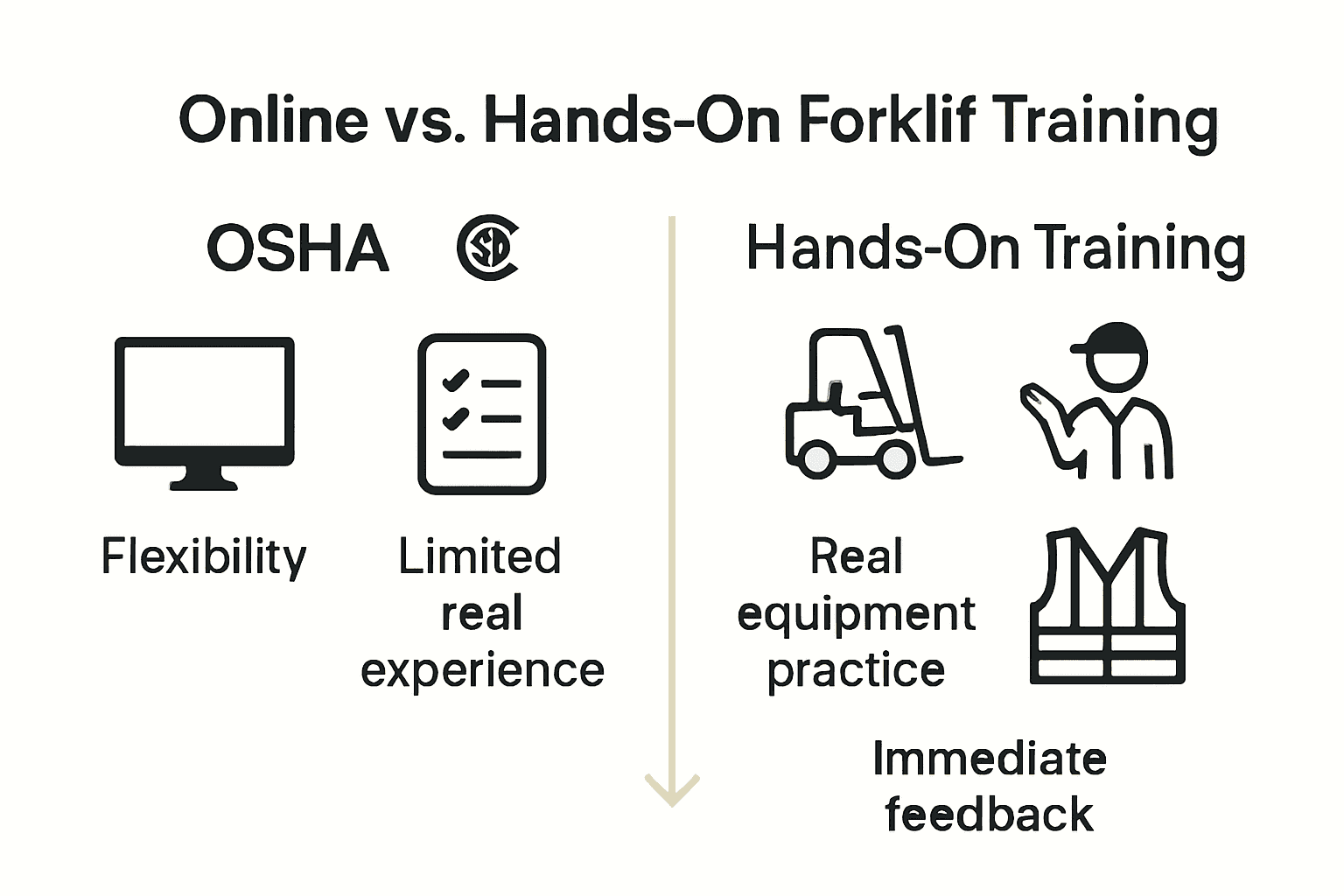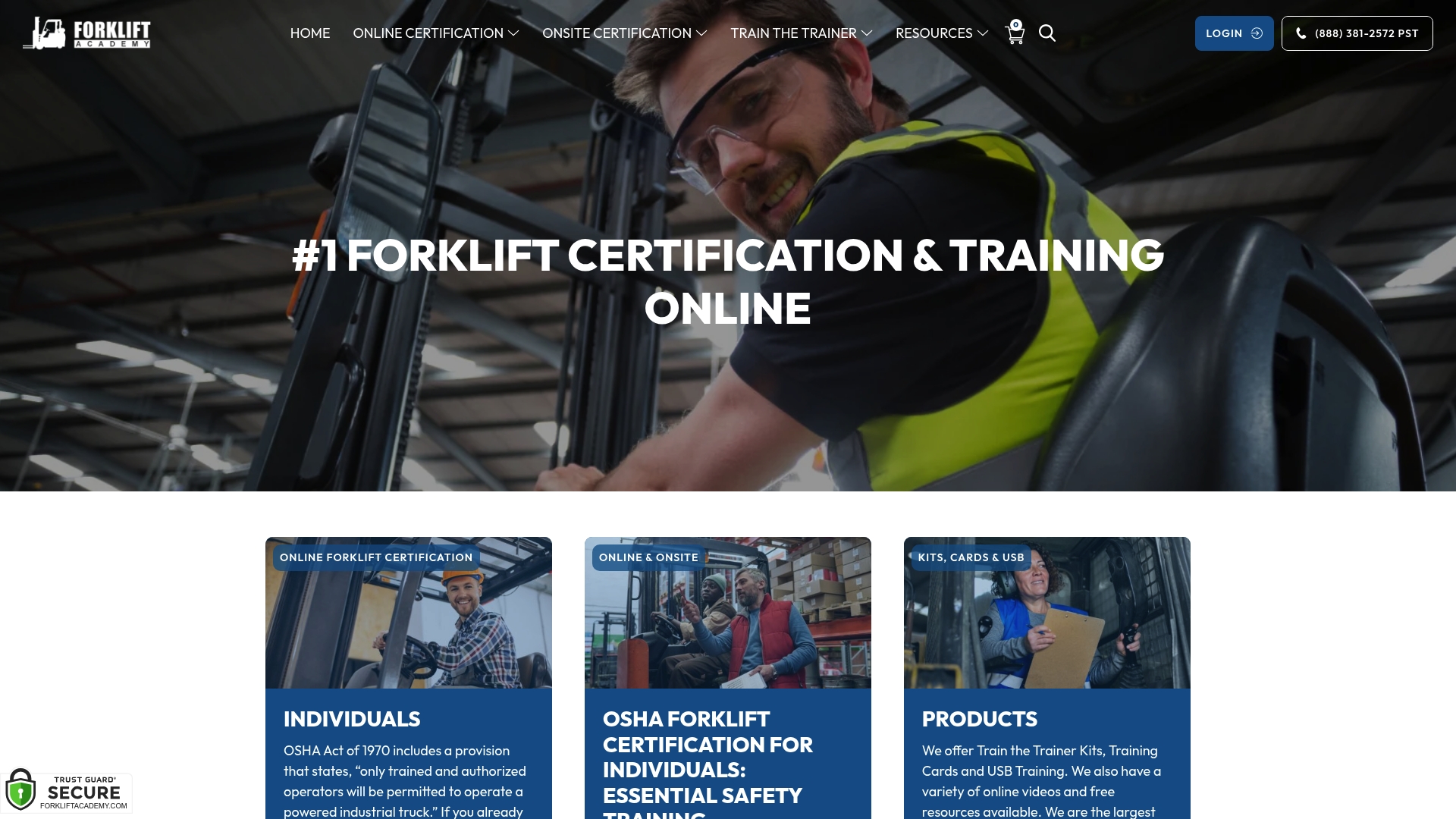
Forklifts account for over 34,000 serious injuries in workplaces each year, yet many new operators feel unprepared after basic training. The right instruction goes far beyond reading a manual or watching online tutorials. Successful forklift training connects real-world practice with expert supervision, guiding beginners step by step to build genuine confidence and skill. This approach bridges the gap between theory and safe, effective machine operation, setting a higher standard for industrial safety.
| Point | Details |
|---|---|
| Hands-On Training is Essential | Hands-on forklift training is critical for developing operational proficiency and safety awareness in novice operators. |
| Regulatory Compliance is Mandatory | Adhering to OSHA and CSA guidelines is crucial; operators must complete formal training and pass hands-on assessments for certification. |
| Online Training Has Limitations | While convenient, online training lacks the practical experience necessary for true skill acquisition, making hands-on practice vital. |
| Focus on Comprehensive Skill Development | Effective training programs prioritize critical skills like load management, safety protocols, and emergency response for workplace efficiency and safety. |
Hands-on forklift training programs are comprehensive skill development approaches designed to transform novice operators into proficient and safety-conscious professionals. According to on-the-job training research, these programs focus on direct workplace learning where employees gain practical experience under experienced guidance.
A hands-on forklift training program typically involves structured learning that combines theoretical knowledge with practical machine operation. Operators learn critical skills through direct interaction with industrial trucks, supervised practice, and scenario-based training. OSHA-compliant training approaches emphasize not just technical operation, but comprehensive safety protocols that protect both the operator and surrounding workplace environment.
The core components of effective hands-on training include:
By prioritizing direct experience and professional mentorship, these training programs ensure operators develop the confidence and competence necessary for safe, efficient forklift operation across diverse industrial settings.

Forklift training has evolved to offer two primary approaches: online learning and hands-on, in-person instruction. According to research from training certification experts, these methods each provide unique advantages for aspiring forklift operators. Explore the pros and cons of online forklift training to understand which approach might best suit your learning needs.
Online training provides flexibility and cost-effectiveness, allowing operators to complete theoretical components at their own pace. However, these digital programs have significant limitations. As industry research indicates, online training lacks the critical real-world operational experience essential for developing comprehensive machine handling skills. Operators must supplement digital learning with practical evaluation to meet certification requirements.
In contrast, hands-on training offers immediate, supervised instruction with direct equipment interaction. Key benefits include:
While online training offers convenience, hands-on programs remain the gold standard for developing confident, competent forklift operators. The most comprehensive training strategies often combine both approaches, leveraging digital learning’s accessibility with in-person training’s practical skill development.

Here’s a comparison of online and hands-on forklift training approaches:
| Feature | Online Training | Hands-On Training |
|---|---|---|
| Learning Format | Digital/self-paced | In-person/supervised |
| Flexibility | High | Moderate |
| Cost | Lower | Higher |
| Real Equipment Access | None | Full |
| Instructor Feedback | Limited | Immediate |
| Safety Protocol Demo | Theoretical only | Direct, practical |
| Skill Assessment | Written tests | Practical evaluation |
| Certification Validity | May require hands-on | Meets OSHA/CSA standards |
Forklift operator training involves strict regulatory requirements designed to ensure workplace safety and operational competence. Understanding OSHA compliance is crucial for businesses and individual operators seeking to meet legal standards for industrial vehicle operation.
OSHA Guidelines 1910.178 mandates comprehensive training for all powered industrial truck operators. According to official research, this regulation requires that every forklift operator must be formally trained and authorized before operating equipment at any job site. The guidelines cover multiple aspects of operator preparation, including theoretical knowledge, practical skills, and workplace-specific safety protocols.
Key compliance requirements include:
While online training can cover theoretical components in approximately one hour, OSHA explicitly requires a qualified professional to perform a hands-on skills assessment before an operator can independently use a forklift. This two-stage approach ensures that operators not only understand safety principles but can also demonstrate practical competence in real-world workplace environments.
Forklift training goes far beyond simple machine operation, focusing on developing comprehensive skills that ensure workplace safety and operational excellence. Explore the critical skills every forklift operator must master to understand the depth of professional preparation required in this field.
Technical proficiency forms the core of forklift training, encompassing more than just driving techniques. Operators learn intricate skills including precise load management, spatial awareness, equipment inspection, and advanced maneuvering in complex workplace environments. These skills are crucial for preventing accidents, minimizing equipment damage, and maintaining workplace efficiency.
Key skills taught during comprehensive forklift training include:
Beyond technical skills, training programs emphasize safety consciousness and professional judgment. Operators learn to anticipate potential risks, make split-second decisions, and prioritize workplace safety over expedient but dangerous shortcuts. This holistic approach ensures that certified forklift operators are not just technically competent, but also responsible, alert professionals who contribute to a safer work environment.
Forklift training presents numerous potential pitfalls that can compromise both operator safety and certification effectiveness. Learn how to navigate the most common training challenges to ensure a comprehensive and successful learning experience.
Online training limitations represent a significant challenge for aspiring forklift operators. Research indicates that digital programs often lack the critical hands-on experience necessary for true skill development. Many online courses provide theoretical knowledge but fall short in delivering practical, real-world operational skills. Some employers may even reject certifications that do not include a comprehensive hands-on component, potentially limiting future job opportunities.
Common mistakes and challenges to avoid during forklift training include:
Technological interruptions and incomplete training can create dangerous knowledge gaps. Successful forklift operators must approach their training holistically, combining theoretical understanding with practical experience, and maintaining a continuous commitment to safety and skill refinement. The most effective training programs emphasize adaptability, situational awareness, and a proactive approach to workplace safety.
Safety and real-world experience are the heart of every effective forklift training program. The article highlights the challenges operators face when relying solely on theory without proper hands-on practice. You need more than just knowledge – you want to develop true operational skills, OSHA compliance, and the confidence to handle any workplace scenario. Avoid common pitfalls like skipping supervised skill assessments or neglecting equipment familiarization.
Forkliftacademy.com offers exactly the hands-on and comprehensive training solutions that meet these needs. Whether you seek individual certification or a full business safety program, our OSHA-compliant courses fuse practical experience with expert instruction. We provide flexible onsite training at major U.S. cities supported by online learning to reinforce your understanding and expedite compliance.
Unlock your potential in forklift operation with proven skills and safety awareness. Explore practical certification options in our Forklift License Archives – Top Osha Forklift Certification and deepen your knowledge on workplace safety through our Forklift Safety Archives – Top Osha Forklift Certification.

Ready to transform your forklift training? Visit Forkliftacademy.com now to access trusted programs designed to elevate your performance and keep your workplace secure. Don’t wait to build real expertise and compliance—start your hands-on journey today.
Hands-on forklift training programs typically include supervised machine familiarization, safety protocol instruction, practical operational techniques, real-world scenario simulation, and individual skill assessment.
Hands-on training provides immediate, supervised instruction with direct interaction with equipment, whereas online training offers flexibility but lacks practical, real-world experience essential for developing comprehensive machine handling skills.
OSHA mandates that forklift operators complete a formal training program, pass a written examination, undergo practical skills assessment, receive workplace-specific operational training, and participate in periodic re-certification and performance evaluations.
Key skills taught during forklift training include load stability techniques, spatial awareness, pre-operational equipment safety checks, hazard recognition, emergency response protocols, and effective communication in workplace settings.